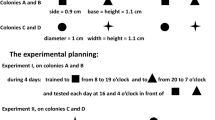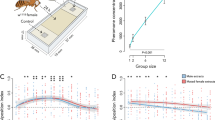Summary
Observations made on colonies ofV. orientalis show that there are some pupae whose orientation in the comb prior to eclosion does not correspond to the geotropic orientation of the majority of pupae. Geotropic natural errors are discussed vis-a-vis their effect on the various developmental stages, and are shown to be lethal to the brood at the end of the pupae stage.
Experiments were carried out in order to separate the gravitational cues from the cues originating within the combs cells, resulting that the larvae are responding primarily to cues originating within the cell, and much less so to gravity. The number of disoriented workers is invariable smaller than the number of disoriented sexual forms.
Résumé
L'observation montre que, dans les colonies deVespa orientalis, quelques nymphes avant l'éclosion ne sont pas orientées dans le rayon comme les autres. Nous avons analysé conséquences des erreurs de géotropisme survenant dans les conditions naturelles sur les différents stades de développement. Nous avons montré qu'elles sont létales pour le couvain à la fin de la nymphose.
Des expériences qui ont été réalisées pour séparer les facteurs de gravité de ceux qui proviennent des alvéoles, il ressort que les larves répondent principalement aux facteurs alvéolaires et beaucoup moins à la pesanteur. Le nombre d'ouvrières issues d'alvéoles mal orientés est toujours inférieur à celui des sexués issus de tels alvéoles.
Similar content being viewed by others
References
Evans (H. E.) andEberhard (M. J. W.), 1970. — The Wasps.University of Michigan Press, Publ., Ann. Arbor, 265 p.
Ishay (J.), 1964. — Observations sur la biologie de la Guêpe orientaleVespa orientalis, Ins. Soc., 11, 193–206.—Ishay (J.), 1967. Observations on the behaviour of the different members of a colony of the Oriental hornetVespa orientalis. Thesis, Hebrew Univ., Jerusalem.
Ishay (J.), Gitter (S.), Schaudinischky (L.) andSchwartz (A.), 1972. — Cybernetic process between the adults and the larvae of the oriental hornetVespa orientalis. 6th Cong. Int. Cybernetics, Namur.
Ishay (J.), Motro (A.), Gitter (S.) andBrown (M. B.), 1974. — Rythms in acoustical communication by the Oriental hornetVespa orientalis.Anim. Behav., 22, 741–744.
Malyshev (S. J.), 1968. — Genesis of the Hymenoptera and the phases of their evolution.Methuen, Publ., London, 319 p.
Montagner (H.), 1964. — Instinct et mécanismes stéréotypés chez les guêpes sociales.Psych. Fr., 9, 257–279.
Pardi (L.), 1965. — Personal Communication.
Spradbery (J. P.), 1973. — The Waps.Sidgwick and Jackson, Publ. London, 408 p.
Wafa (A. K.) andSharkawi (S. G.), 1972. — Contribution to the biology ofVespa orientalis Fab.,Bull. Soc. ent., Egypte,56, 212–226.
Author information
Authors and Affiliations
Rights and permissions
About this article
Cite this article
Ishay, J. Orientation by pupating larvae ofVespa orientalis (Hymenoptera: Vespidae). Ins. Soc 22, 67–73 (1975). https://doi.org/10.1007/BF02223124
Received:
Accepted:
Issue Date:
DOI: https://doi.org/10.1007/BF02223124




